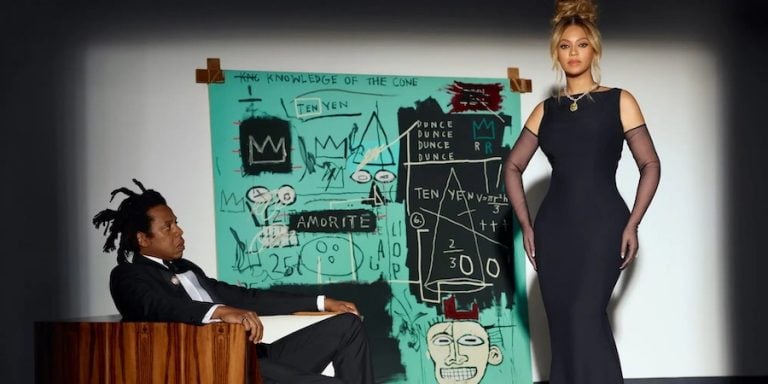Friends and collaborators of Jean-Michel Basquiat have criticized the recent Tiffany & Co. campaign starring Jay-Z and Beyoncé.
Several close friends and collaborators of the late artist, who died in 1988, have condemned the campaign that featured a never-before-seen Basquiat original, Equals Pi.
The complaints are entrenched in criticism of the commercialization of Basquiat’s art. “I’d seen the ad a couple days ago and I was horrified,” Alexis Adler, who lived with Basquiat from 1979 to 1980, told Daily Beast.
“The commercialization and commodification of Jean and his art at this point—it’s really not what Jean was about.”
Adler noted that if Basquiat were alive, he would have wanted his paintings available for the public to see at the museums. Equals Pi will be a permanent fixture in Tiffany’s flagship Fifth Avenue store.
“Unfortunately, the museums came to Jean’s art late, so most of his art is in private hands and people don’t get to see that art except for the shows. Why show it as a prop to an ad?” Adler continued. “Loan it out to a museum. In a time where there were very few Black artists represented in Western museums, that was his goal: to get to a museum.”
Al Diaz, a creative collaborator of Basquiat who worked alongside him on their street art duo SAMO, criticized Tiffany for associating Basquiat’s work with his interest in luxury.
Love Music?
Get your daily dose of metal, rock, indie, pop, and everything else in between.
“People think that his association with luxury was because he was impressed with that shit, but he couldn’t care less,” Diaz said. “It’s not just about wearing an Armani suit. If he wore it, it’s because he could buy it and fuck it up, it wasn’t because the stitches were fabulous or well-made.”
Stephen Torton, a former assistant of Basquiat, opined that he believes Tiffany would not have let Basquiat into their stores when he was alive.
“They wouldn’t have let Jean-Michel into a Tiffany’s if he wanted to use the bathroom, or, if he went to buy an engagement ring and pulled a wad of cash out of his pocket. We couldn’t even get a cab,” said Torton.
The Tiffany campaign, unveiled last month, features Beyoncé donning the fabled 128.54-carat yellow Tiffany diamond, discovered in South Africa in 1877 at the Kimberley Mine by Charles Lewis Tiffany.
The campaign incited widespread criticism. Social media users highlighted the bleak history of white supremacy and colonialism behind the stone necklace. With some going as far to say that Beyoncé was donning a “blood diamond.”
In the 1970s, when the stone was discovered, British forces had launched battles of conquest against African tribes and laborers. This tumultuous mining industry paved the way for apartheid.


































